Florida is surrounded by water on most sides, so it naturally hosts numerous shark species. It is also the state with the most shark attack records: a total of 896 unprovoked attacks. New Smyrna Beach in Florida is known as the “shark capital of the world.”
If you’ve ever wondered what shark species live in the area and how large they can be, we’re here to help you! We’ve prepared a list of the eight biggest sharks near Florida beaches. The data in this article is based on a study that examined 3,398 sharks caught and released off Miami and the Florida Keys.
Results showed that Florida hosts 15 species of sharks, the most common ones being nurse sharks and blacktip sharks. However, the numbers may vary, as Florida waters may host many more sharks than people have ever seen. The information provided by the study can help create a general image of Florida’s shark population. Let’s find out what the biggest sharks are in the area!
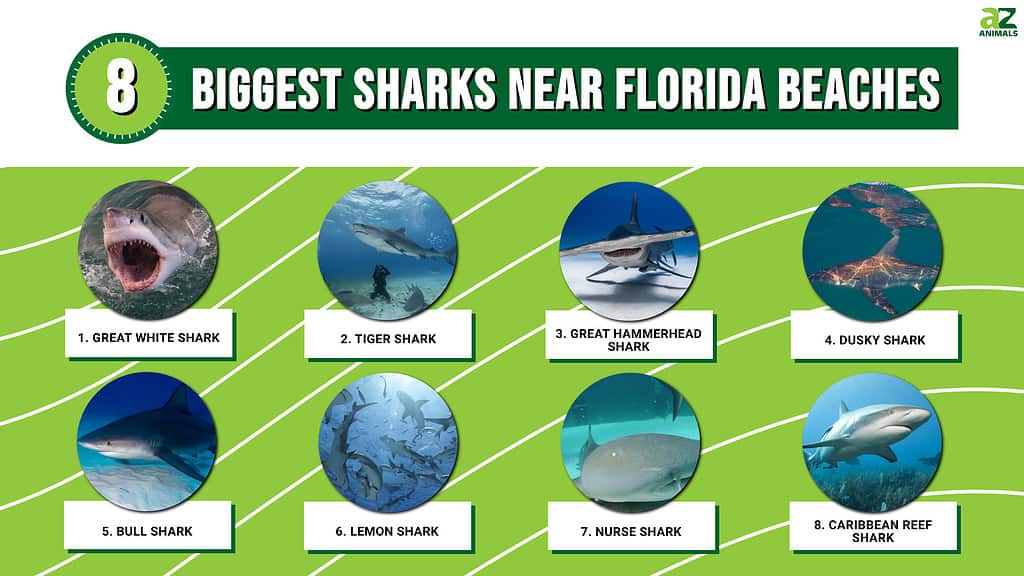
1. Great White Shark

Among all the sharks in Florida, the great white shark is the largest.
©Alessandro De Maddalena/Shutterstock.com
| Scientific Name | Length | Number of Sharks |
|---|---|---|
| Carcharodon carcharias | 18-26 ft (5.4-7.9 m) | 1 |
The study discovered only one great white shark in the area, although there might be more. Among all the other sharks in Florida, the great white is the largest, growing as long as 26 feet (7.9 m) and weighing as much as 4,200-5,000 pounds (1,905-2,267 kg). It is considered the most aggressive shark worldwide. White sharks live in temperate, coastal, and open ocean waters. They feed on seals, porpoises, sea lions, dolphins, and smaller whales.
2. Tiger Shark
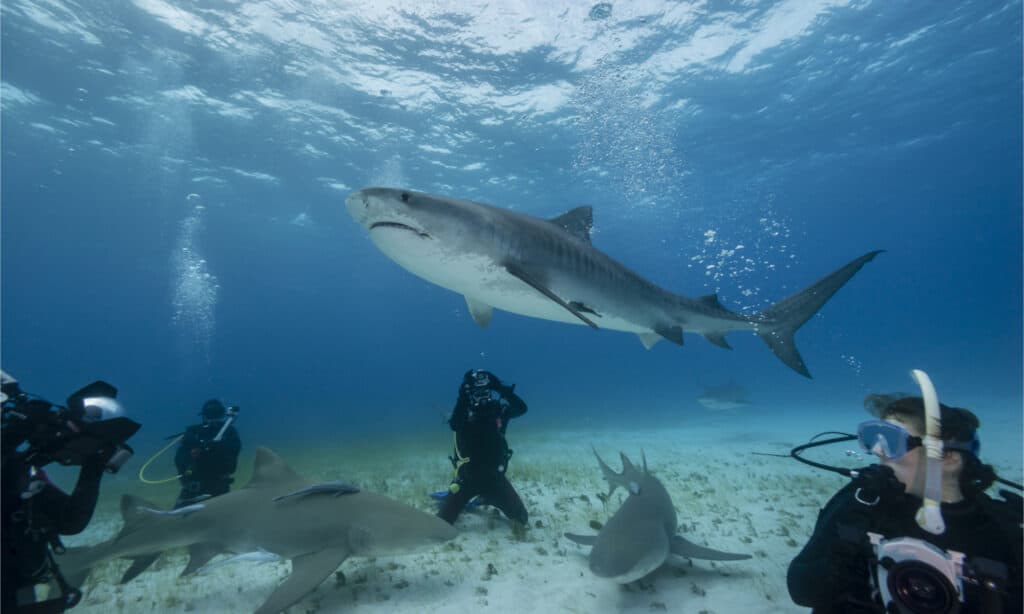
Tiger
sharks are also called “garbage fish” because they can eat almost anything, thanks to their unique teeth.
©wildestanimal/Shutterstock.com
| Scientific Name | Length | Number of Sharks |
|---|---|---|
| Galeocerdo cuvier | 10-14 ft (3-4.2 m); longest tiger shark: 24.6 ft (7.4 m) | 100 |
The tiger shark, also known as leopard shark, is a warm, saltwater fish. They are also called “garbage fish” because they can eat almost anything, thanks to their unique teeth. Scientists found various items in a tiger shark’s stomach, including plastic and empty cans. These sharks’ average length is 10-14 feet (3-4.2 m), but the longest tiger shark recorded measured an astonishing 24.6 feet (7.4 m) long. Leopard sharks feed on squid, dolphins, sea turtles, clams, rays, and sea birds. After the great white, the tiger shark is the second most aggressive shark in the world.
3. Great Hammerhead Shark
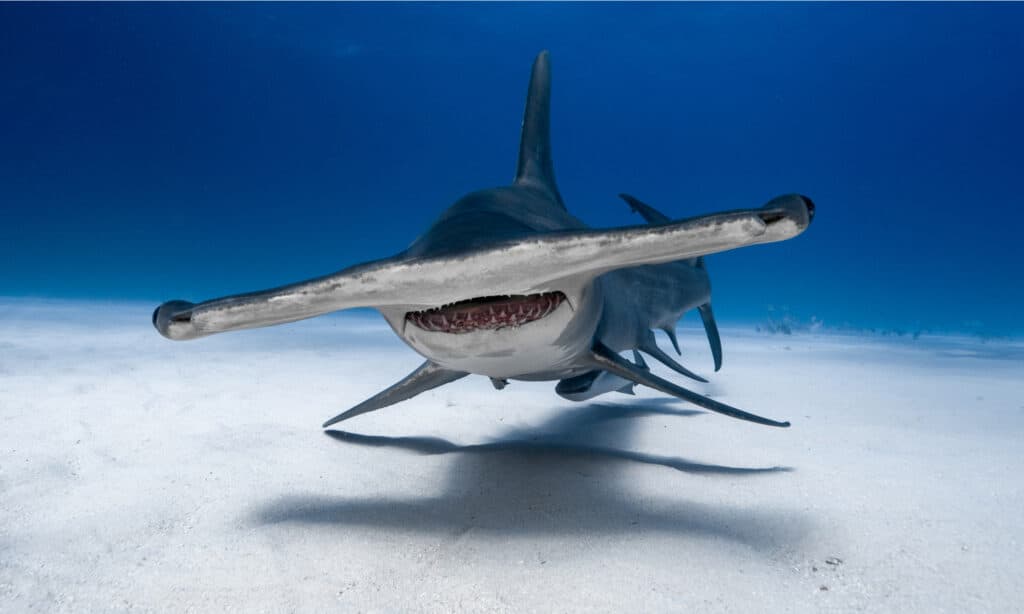
The average length of a great hammerhead shark is 10-14 feet.
©Sail Far Dive Deep/Shutterstock.com
| Scientific Name | Length | Number of Sharks |
|---|---|---|
| Sphyrna mokarran | 10-14 ft (3-4.2 m); longest great hammerhead: 20 ft (6.1 m) | 238 |
Great hammerhead sharks prefer living in shallow waters, not going deeper than approximately 900 feet (274 m). Their average length is 10-14 feet (3-4.2 m), although the longest great hammerhead shark discovered measured 20 feet (6.1 m). These aquatic animals feed on stingrays, bony fish, crustaceans, small sharks, squid, and octopuses.
Sphyrna mokarran is considered an aggressive type of shark that can attack if threatened.
4. Dusky Shark
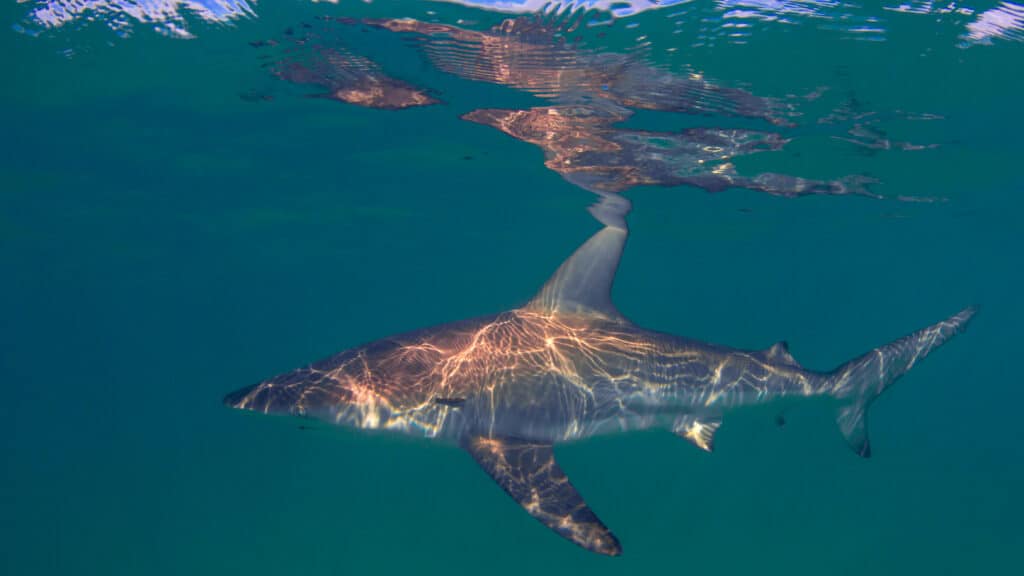
The dusky shark’s maximum recorded length is 14 feet.
©Rich Carey/Shutterstock.com
| Scientific Name | Length | Number of Sharks |
|---|---|---|
| Carcharhinus obscurus | 10-14 ft (3-4.2 m) | 5 |
Dusky sharks have brown, blue, or gray shades and a pale white underbelly. A dusky shark’s maximum recorded length is 14 feet (4.2 m). They are solitary creatures that live in the Atlantic and the Eastern Pacific. Sometimes they migrate in groups to the north during spring and summer and to the south during winter. This happens because they prefer living in tropical and temperate waters, ranging between 66 and 82 degrees Fahrenheit (18.8 and 27.7 Celsius). Besides the United States, dusky sharks have been spotted in the Canary Islands, Bay of Bengal, Vietnam, China, Japan, Taiwan, and Australia.
5. Bull Shark
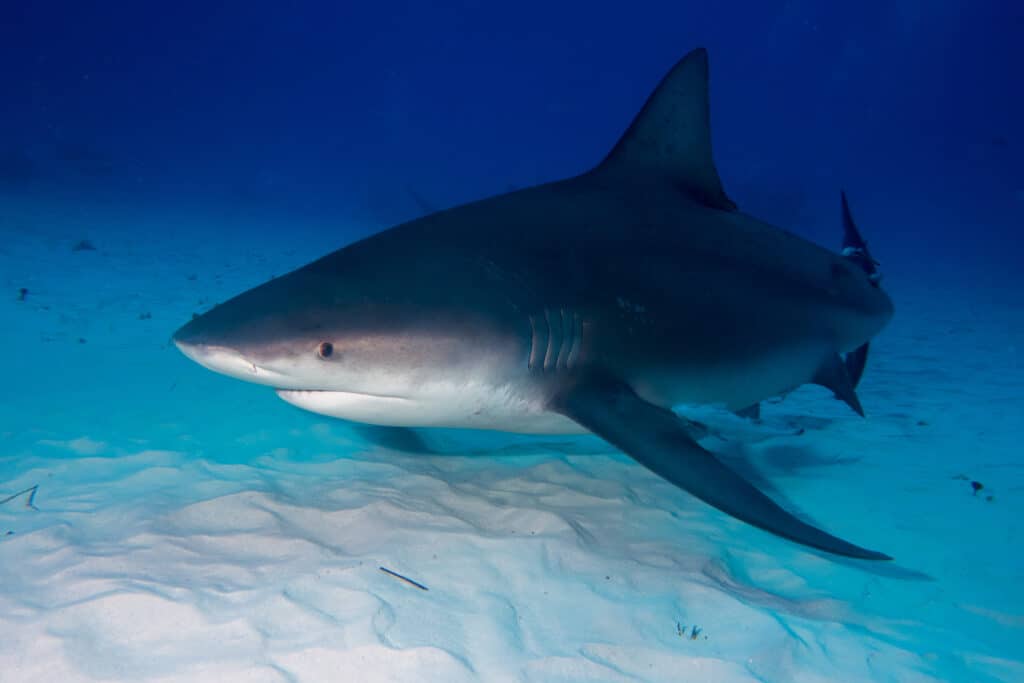
Bull sharks are aggressive species of shark that live in warm coastal waters.
©HakBak/Shutterstock.com
| Scientific Name | Length | Number of Sharks |
|---|---|---|
| Carcharhinus leucas | 7-11.5 ft (2.1-3.5 m); largest bull shark: 13 ft (3.9 m) | 253 |
Bull sharks are aggressive species of shark that live in warm coastal waters. They are responsible for many shark attacks because they rarely swim in waters deeper than 100 feet. Carcharhinus leucas usually grow as large as 11 feet (3.5 m). However, the largest bull shark found was 13 feet (3.9 m) long.
Bull sharks feed on almost anything they can find, but they usually catch fish, sea turtles, dolphins, birds, rays, and other smaller sharks. Some bull sharks have been killed by other sharks and crocodiles.
6. Lemon Shark
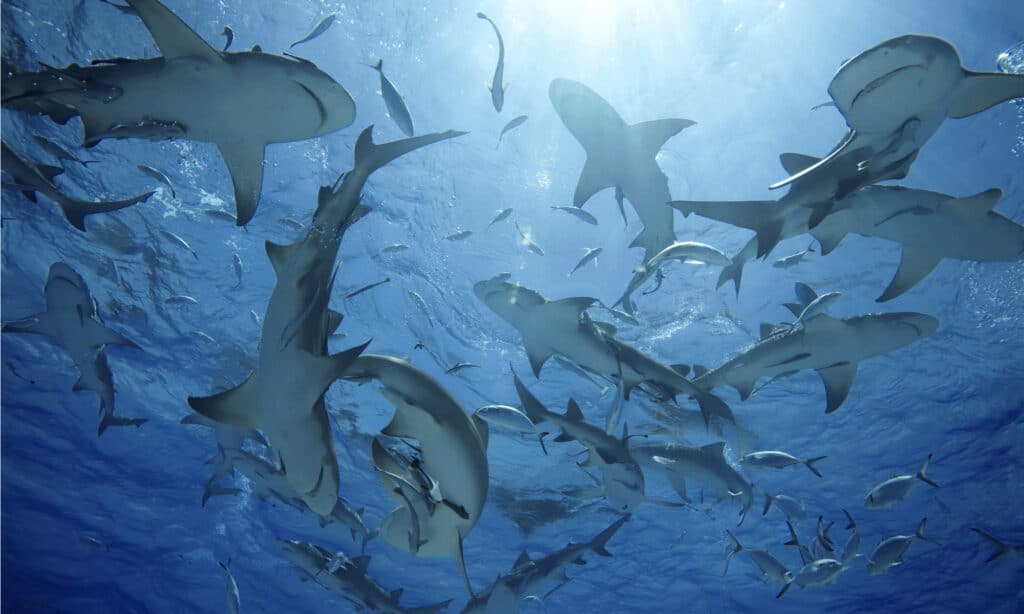
Lemon sharks live in shallow subtropical waters and tend to feed during the night.
©Yann hubert/Shutterstock.com
| Scientific Name | Length | Number of Sharks |
|---|---|---|
| Negaprion brevirostris | 7.9-10.2 ft (2.4-3.1 m); longest lemon shark: 11.3 ft (3.4 m) | 314 |
Lemon sharks usually do not grow longer than 10-11 feet (2.4-3.1 m). The longest lemon shark ever recorded measured 11.3 (3.4 m) feet long. They live in shallow subtropical waters and tend to feed during the night. Their main food source consists of fish, crustaceans, and benthic organisms. Studies show that lemon sharks can feed on smaller lemon sharks.
They are social aquatic creatures living in groups. Lemon sharks were not involved in many shark attacks compared to other large sharks. If not threatened, they are not considered extremely dangerous to humans.
7. Nurse Shark
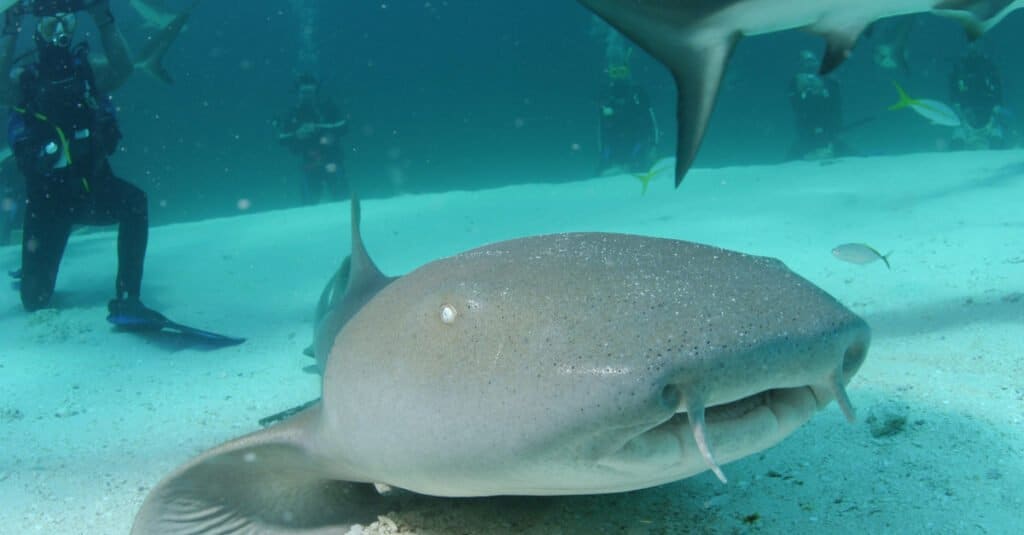
Nurse sharks feed mainly on small fish and invertebrates such as molluscs, stingrays, and crustaceans.
©tali de pablos/Shutterstock.com
| Scientific Name | Length | Number of Sharks |
|---|---|---|
| Ginglymostoma cirratum | 7.5-9 ft (2.2-2.7 m) | 1,335 |
Nurse sharks are the fourth most dangerous species worldwide, considering the total number of bites on humans. This species was also one of the most commonly encountered around the Florida Keys (as per the study mentioned above).
At the moment, nurse sharks are classified as a vulnerable species. They feed mainly on small fish and invertebrates such as molluscs, stingrays, and crustaceans.
The species is known for its ability to handle capture and tagging. This is the main reason why nurse sharks are important for the research of this incredible aquatic animal.
8. Caribbean Reef Shark
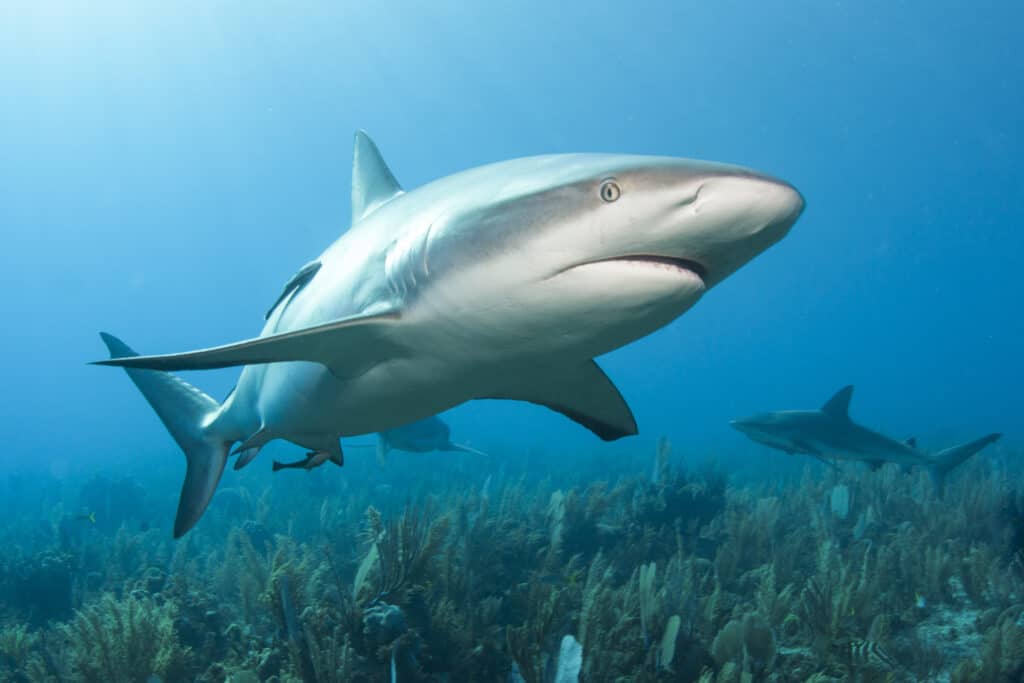
Caribbean reef sharks have an average length of about 8.2 feet.
©Konstantin Novikov/Shutterstock.com
| Scientific Name | Length | Number of Sharks |
|---|---|---|
| Carcharhinus perezi | 6.5-8.2 ft (1.9-2.5 m) | 13 |
As its name implies, the Caribbean reef shark is commonly found in the Caribbean Sea. It is a requiem shark, meaning it’s migratory and enjoys warm seas. The species’ body is streamlined and robust and adapted to its migratory nature.
Caribbean reef sharks have an average length of about 8.2 feet (2.5 m), but specimens of up to 9.8 feet (3 m) exist. The species is one of the largest reef apex predators. Its diet consists mainly of cephalopods and various fishes.
Summary of the 8 Biggest Sharks Near Florida Beaches
Here’s a recap of the eight largest shark species seen close to beaches in Florida:
| Rank | Shark | Length |
|---|---|---|
| 1 | Great White Shark | 18-26 ft |
| 2 | Tiger Shark | 10-14 ft; longest: 24.6 ft |
| 3 | Great Hammerhead Shark | 10-14 ft; longest: 20 ft |
| 4 | Dusky Shark | 10-14 ft |
| 5 | Bull Shark | 7-11.5 ft; longest: 13 ft |
| 6 | Lemon Shark | 7.9-10.2 ft; longest: 11.3 ft |
| 7 | Nurse Shark | 7.5-9 ft |
| 8 | Caribbean Reef Shark | 6.5-8.2 ft |
The photo featured at the top of this post is © ilan elgrably/Shutterstock.com
Thank you for reading! Have some feedback for us? Contact the AZ Animals editorial team.






